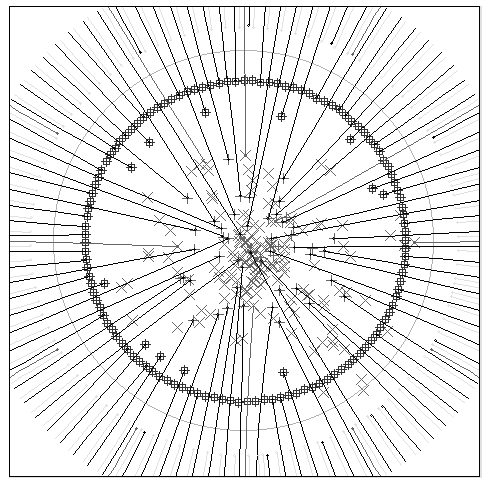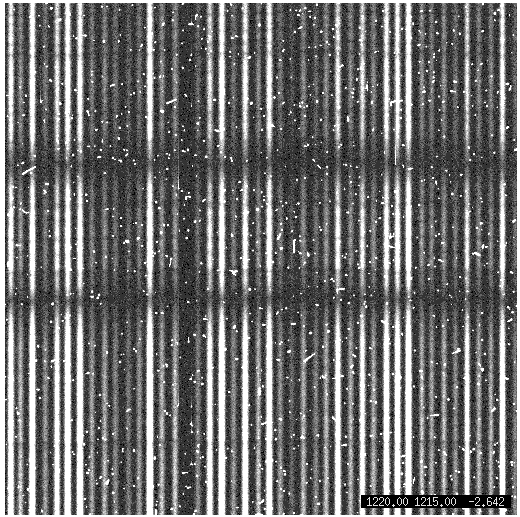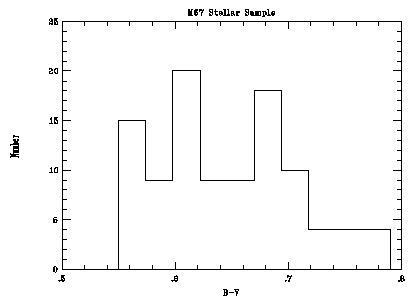A Survey of Chromospheric Activity in the Solar-Type Stars in M67
Mark S. Giampapa (National Solar Observatory)
2. Observational Approach
We are utilizing the 3.5-m WIYN telescope in conjunction with the Hydra
multi-fiber positioner to perform multi-object spectroscopy over a
1 degree field. We use a bench-mounted spectrograph with the T2KC CCD,
Simmons camera and the 1200 l mm-1 grating in second order.
Two blocking filters (BG38 & BG39) must be employed to suppress red leak
at the sacrifice of some throughput; these filters will soon be replaced
in this program by a single CuSO4 filter, thus increasing our
throughput. This configuration yields a spectral resolution of about
0.80 A in the 3950 A region between the Ca II K and H lines, as
measured by the FWHMs of the CuAr comparison lines.
We display in Figure 1 a diagram from the Hydra simulator
illustrating the placement of the fiber positioner for target stars in the
M67 field. While 100 blue fiber cables are available, only about half of
them can be positioned at targets because of the disallowed proximity of
fibers that inevitably occurs (i.e., fiber-fiber interactions) in
centrally condensed fields. Thus multiple Hydra configurations are
required to obtain spectra of the entire sample. At approximately a distance
of 870 pc (Montgomery et al. 1993), solar-type
stars in M67 are relatively faint with V ~14.5. It is really the
advent of the Hydra multi-object spectrograph on a 4-m class telescope that
enables the efficient conduct of a survey of ~100 solar-type stars based
on K-line spectroscopy. Nevertheless, spectroscopy of cool stars in the blue
is still challenging even with a relatively large-aperture telescope such as
the WIYN telescope. A raw Hydra frame comprised of the sum of 4 x
3600 sec frames is displayed in Figure 2. Differences in intensity are due both
to differences in V-magnitude and to variations in fiber throughput which can
change by up to a factor of ~3 from one fiber to the next.

FIGURE 1:Hydra simulator showing the
positioning of fibers for a target field in M67.

FIGURE 2:An example of a raw
Hydra frame consisting of the sum of 4 x
3600 sec individual frames for solar-type stars in M67. The dispersion
direction is vertical in the figure. The Ca II H and K
lines are evident as prominent dark bands in the frame.
2.1. Stellar Sample
The stars are selected from the Girard et al. (1989) proper motion
study combined with the CCD photometry given by Montgomery et al. (1993).
For those objects from the Girard et al. study where photometry from
Montgomery et al. is not available, we adopt the photometry given by
Sanders (1977). We include only stars that have a membership probability of
>= 90% as given by Girard et al. (1989). Our photometric criteria
include stars in the range of apparent brightness of 14 <= V <= 15
and intrinsic color of +0.55 <= (B-V) <= +0.78, where we adopt a value
of E(B-V)=0.05 for the color excess in M67 (Montgomery et al. 1993). The
resulting spectral range of the sample is ~ F8 - K0. A histogram
in intrinsic (B-V) color of the sample is given in Figure 3. In this way, we
can ensure that we are observing stars that are very close to the Sun in their
photospheric properties.

FIGURE 3:A histogram
in (B-V) color of the stars observed in this program.
The stellar sample emphasizes solar analogs where we adopt (B-V) = +0.65
for the Sun.
[Prev | Next ]
[Contents]



